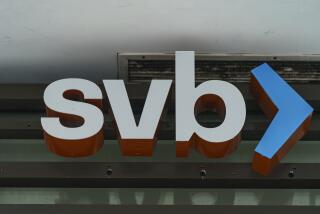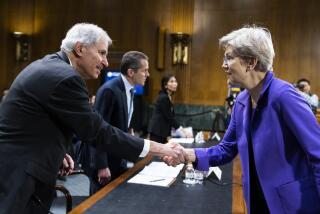Fed dings 3 banks but says 30 others can boost dividends and buy back shares
- Share via
The Federal Reserve has given the green light to major banks in the U.S. to raise dividends and buy back shares, judging them to have a sturdy enough financial foundation to withstand a major economic downturn.
But the Fed on Wednesday gave Morgan Stanley only conditional approval because of what were considered weaknesses in its plans dealing with risks. Morgan Stanley has until the end of the year to submit a new capital plan.
As a result of its annual “stress tests,” the Fed rejected plans by the U.S. divisions of two European banks, Germany’s Deutsche Bank and Spain’s Santander.
The remaining 30 banks are allowed to raise dividends or repurchase shares. They include JPMorgan Chase, Bank of America, Citibank and Wells Fargo, the four biggest U.S. banks.
The stress tests are an annual checkup of the biggest financial institutions in the U.S. This was the sixth year of the tests. Thirty-three banks were tested to determine whether they have enough capital buffers to keep lending, even if faced with billions of dollars in losses in another financial crisis and severe economic downturn.
“The participating firms have strengthened their capital positions and improved their risk-management capacities,” Fed Gov. Daniel Tarullo said in a statement. “Continued progress in both areas will further enhance the resiliency of the nation’s largest banks.”
The tests were mandated by Congress in the wake of the financial crisis that struck in 2008 and plunged the U.S. into the worst economic downturn since the Great Depression of the 1930s.
The announcement on the second round of the stress tests followed last week’s initial results. The regulators determined that the 33 big banks hold more capital than at any time since the crisis and are adequately fortified to withstand a severe U.S. and global recession and continue lending.
Under the Fed’s most extreme hypothetical scenario in this year’s tests, the U.S. economy falls into a deep recession causing the stock market to plunge by 50%. Unemployment climbs above 10%, while housing prices drop by 25% and commercial real estate prices tumble 30%. In this scenario, investors would be so panicked that yields on short-term U.S. Treasury securities would go negative — meaning even the safest of assets still would lose money.
Beyond hypotheticals, big banks took a huge hit from Britain’s vote last week to leave the European Union. As a sector, their shares took the largest losses by far, as stocks plunged in the U.S. and worldwide Friday, when results of the historic vote became known.
Stock prices since have recovered, but uncertainty remains. U.S. banks have a lot to lose in Britain’s departure from the 28-nation bloc because they do a lot of cross-border business in Europe from their offices in London. They also become less profitable when bond yields fall because that lowers interest rates on mortgages and many other kinds of loans.
Fed officials change the stress test scenarios each year to reflect the current economic climate around the world. This year’s did include a severe recession in Britain and in the bloc of countries that use the Euro currency — but not a “Brexit” move by Britain to leave the EU.
The Fed said the 33 big banks would sustain $385 billion in loan losses under the most dire scenario. But even with those losses, all the banks together still would hold a high-quality capital ratio of 8.4%, well above the 4.5% minimum. Capital ratios are an industry measure of how strong a bank is.
More to Read
Inside the business of entertainment
The Wide Shot brings you news, analysis and insights on everything from streaming wars to production — and what it all means for the future.
You may occasionally receive promotional content from the Los Angeles Times.










